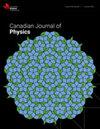Fermi velocity and effective mass of quasiparticles in bilayer phosphorene nanoribbons
IF 1
4区 物理与天体物理
Q3 PHYSICS, MULTIDISCIPLINARY
引用次数: 0
Abstract
Based on the Green’s function approach in combination with the tight-binding approximation, we have investigated the electronic properties of zigzag bilayer phosphorene nanoribbons (ZBLPNRs). A complete and fully reversible metal to semiconductor or insulator phase transition, has been observed via tuning a perpendicular electric field. We explain the effect of the interlayer hopping parameter on the electronic characterizations, namely, the energy band-gap, Fermi velocity and effective mass of carriers in biased ZBLPNRs. In the presence of the interlayer hopping term, the band structure of a ZBLPNR in the vicinity of the Fermi level has a form of two tilted Dirac cones, while, in the absence of it, the created cones are not tilted. Besides, the bands above and below the Fermi level are not symmetric,{\it i.e.}, there is no electron-hole symmetry for both limits of the interlayer coupling. A remarkable tuning of both the Fermi velocity and the reciprocal effective mass can be observed by adjusting the external bias voltage. At certain critical bias voltages, the band edge reciprocal masses and carrier velocities become zero, {\it i.e.}, the electrons exhibit a localization behaviour. This phenomenon indeed is a transition from massive to massless Dirac fermions and vice versa. The possibility of simultaneous control of the thermal and magnetic properties using an electric agent, which can be realized experimentally by using an perpendicular potential difference, open up possibilities for low power consumed thermomagnetic devices based on ZBLPNRs.双层磷烯纳米带中准粒子的费米速度和有效质量
基于格林函数方法,结合紧结合近似,研究了之字形双层磷烯纳米带(ZBLPNRs)的电子特性。一个完全和完全可逆的金属到半导体或绝缘体的相变,已经观察到通过调整垂直电场。我们解释了层间跳变参数对偏置zblpnr中载流子的能带隙、费米速度和有效质量等电子特性的影响。当层间跳变项存在时,ZBLPNR在费米能级附近的能带结构具有两个倾斜的狄拉克锥的形式,而在没有层间跳变项的情况下,所产生的锥不倾斜。此外,费米能级以上和以下的能带是不对称的,{\即},层间耦合的两个极限都不存在电子-空穴对称性。通过调节外部偏置电压,可以观察到费米速度和有效质量的显著调谐。在一定的临界偏置电压下,带边互易质量和载流子速度变为零,电子表现出局域化行为。这种现象确实是从有质量的狄拉克费米子到无质量的狄拉克费米子的过渡,反之亦然。利用电剂同时控制热和磁性能的可能性,可以通过实验实现,利用垂直电位差,为基于zblpnr的低功耗热磁器件开辟了可能性。
本文章由计算机程序翻译,如有差异,请以英文原文为准。
求助全文
约1分钟内获得全文
求助全文
来源期刊

Canadian Journal of Physics
物理-物理:综合
CiteScore
2.30
自引率
8.30%
发文量
65
审稿时长
1.7 months
期刊介绍:
The Canadian Journal of Physics publishes research articles, rapid communications, and review articles that report significant advances in research in physics, including atomic and molecular physics; condensed matter; elementary particles and fields; nuclear physics; gases, fluid dynamics, and plasmas; electromagnetism and optics; mathematical physics; interdisciplinary, classical, and applied physics; relativity and cosmology; physics education research; statistical mechanics and thermodynamics; quantum physics and quantum computing; gravitation and string theory; biophysics; aeronomy and space physics; and astrophysics.
 求助内容:
求助内容: 应助结果提醒方式:
应助结果提醒方式:


